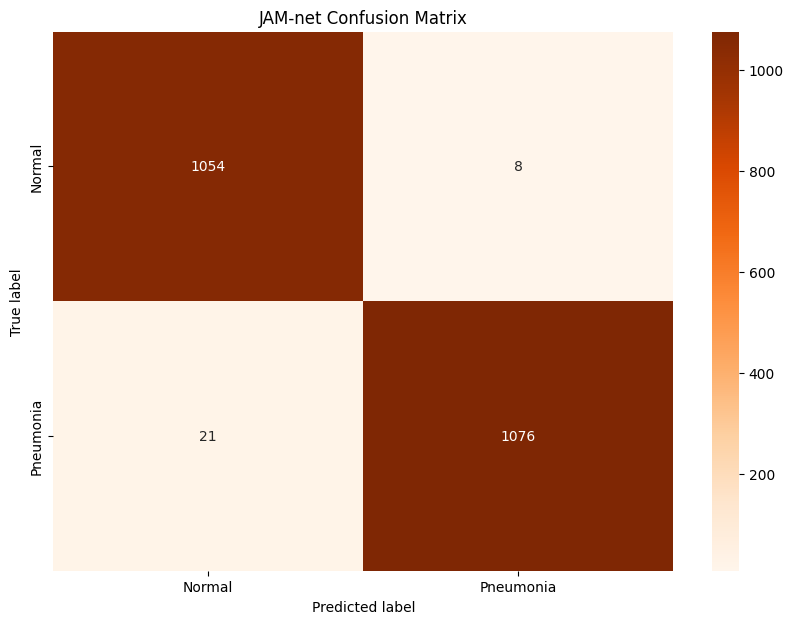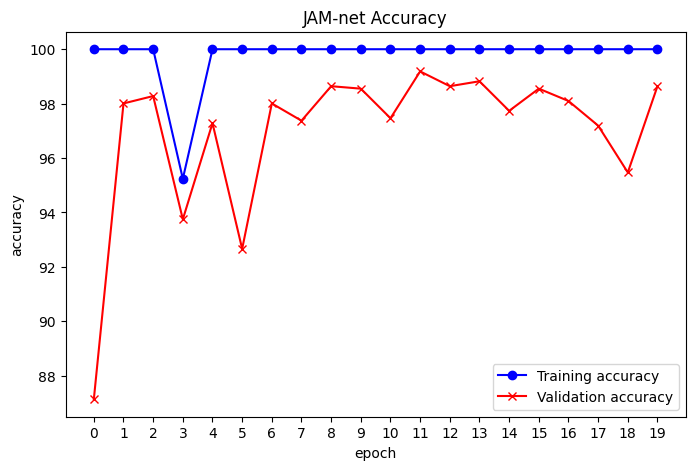JAM-net (Jacopo and Massimo Network) is a deep neural network for pneumonia detection in Chest X-Rays [1]. It's based on FA-net [2] architecture and on KAN (Kolmogorov–Arnold Networks) [3].
In particular, it's composed by the "Fuzzy Channel Selective Spatial Attention Module" of the FA-net [2] and the KAN architecture [3] that substitute the MLP layer at the end.

- Clone the repository:
git clone "https://github.com/cybernetic-m/cv-project.git"
cd cv-projectcv-project
├── README.md
├── images
│ ├── Filtering.jpg
│ ├── accuracy.png
│ ├── architecture.png
│ ├── cm.png
│ ├── data_aug.jpg
│ ├── loss.png
│ ├── resizing.jpg
│ └── final_metrics.png
├── models
│ ├── fa_net_best.pt => Trained model on full dataset with best performance on loss
│ ├── jam_net_best.pt => Trained model on full dataset with best performance on loss
│ └── jam_net_last_epoch.pt =>Trained model on full dataset at last epoch
├── notebook
│ ├── FA_ckan.ipynb => Notebook python that implement FA-net training with ckan
│ └── JAM_full.ipynb => Notebook python that implement JAM-net training
└── references
├── A_Deep_Feature_Learning_Model .pdf
├── KAN- Kolmogorov-Arnold Networks.pdf
├── SOTA_chest_ray.pdf
└── fa_net.pdf
└── CKAN.pdfFor the training phase, we have used the Kermany dataset. It's formed by 5856 chest X-Rays images divided in “Normal” and “Pneumonia” classes. The images are of different sized and the dataset is unbalanced, for this reason the code firstly resize the image and after augment the dataset.
As in the literature [1], we have performed a preprocessing operation on images applying Gaussian, Gaussian + Histogram Equalization filtering and Colormap application to the images.

The training of the network is done with a batch_size=48, early_stopping monitoring the validation loss with a threshold = 1e-4 and a patience = 2, the optimizer is AdamW with a lr = 0.0001 and finally the loss function is the Binary Cross Entropy Loss. The metrics that we measure to validate the model are Accuracy, Precision, Recall, AUROC and F1-Score. We compare the results with the SOTA model [2] without preprocessing:
Performances comparison
Confusion Matrix
Loss Function
Accuracy
Jacopo Tedeschi (https://github.com/jacopotdsc)
[1]. Review on chest pathogies detection systems using deep learning techniques.
[3]. KAN: Kolmogorov–Arnold Networks.
[4]. Convolutional Kolmogorov-Arnold Networks
[7]. FA-Net: A Fuzzy Attention-aided Deep Neural Network for Pneumonia Detection in Chest X-Rays.





